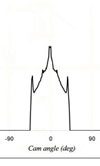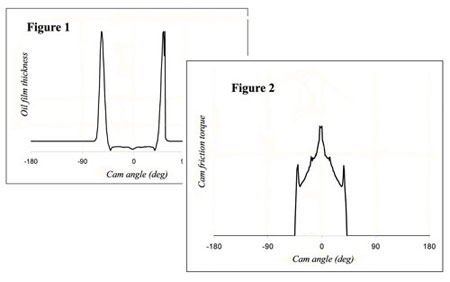Friction and the camshaft
 Perhaps the most noticeable trend in lubricant technology over the last 30 years or so is the movement towards lower viscosity oils. The relentless drive for greater efficiency and hence higher power has led to developments where in the past claims of an increase of up to 25kW have been made in a Formula One engine just by changing the oil. Whether you believe this to be true or not is immaterial but research over the years has shown that reducing the viscosity of the oil can lead to friction reduction in the piston ring pack and the bearings. However with its altogether much more complex lubrication regimes, this does not always follow when it comes to the camshaft. And as indeed is everything about reducing friction, it is all about entrainment velocity or surface finish and often, probably both.
Perhaps the most noticeable trend in lubricant technology over the last 30 years or so is the movement towards lower viscosity oils. The relentless drive for greater efficiency and hence higher power has led to developments where in the past claims of an increase of up to 25kW have been made in a Formula One engine just by changing the oil. Whether you believe this to be true or not is immaterial but research over the years has shown that reducing the viscosity of the oil can lead to friction reduction in the piston ring pack and the bearings. However with its altogether much more complex lubrication regimes, this does not always follow when it comes to the camshaft. And as indeed is everything about reducing friction, it is all about entrainment velocity or surface finish and often, probably both.
To understand cam friction we need to appreciate the basics of general lubrication and remember our old friend - the Stribeck curve. Plotting frictional force against relative velocity for two parallel plates separated only slightly by a fluid, there are three phases. Phase 1 where relative velocity is low the friction is high. Referred to as boundary lubrication, the asperities, which form the peaks and valleys of the magnified surface effectively engage and lock together resisting movement. As the relative velocity begins to increase, the friction falls away sharply until such point as it reaches a minimum. This phase is often referred to as 'mixed ' lubrication. Once the minimum has been reached friction starts building up again, as the role of the viscosity in the fluid begins to take effect. This last zone is often referred to as hydrodynamic lubrication.
Unlike the piston ring pack and bearings, the regime of lubrication in the camshaft, depending on its speed, is generally reckoned to be a mixture of boundary and mixed for much of the time. Excursions into the hydrodynamic zone being brief, the entrainment velocity of the oil during much of the time is relatively low and the lubrication regime spends much of its time running up and down that part of the curve where friction is significant.

Figure 1 shows the oil film thickness from a typical flat tappet arrangement. Along the back of the cam the oil film thickness is moderate and friction is low. Along the flanks entrainment is high, the oil film builds up and friction is also low. However, towards the nose of the cam the entrainment velocity falls, in this case very close to zero, the asperities lock and friction is high. The resulting frictional torque of this flat tappet arrangement when plotted the cam angle is therefore showed in Figure 2. Altering things like the cam profile, increasing the spring loads and reducing valve train mass as well as improving the surface smoothness of both cam and tappet (using processes such as superfinishing or DLC), will change the onset of boundary lubrication and altar the slope of the mixed regime that follows. However unlike the piston ring pack or the bearings, reducing the viscosity of the oil is most likely to increase the friction in the system through higher boundary forces, which do not offset the lower hydrodynamic effects.
Friction modifiers can of course be added but that moves us into an altogether different discussion.
Fig. 1 - Oil film thickness and cam friction torque schematic.
Written by John Coxon